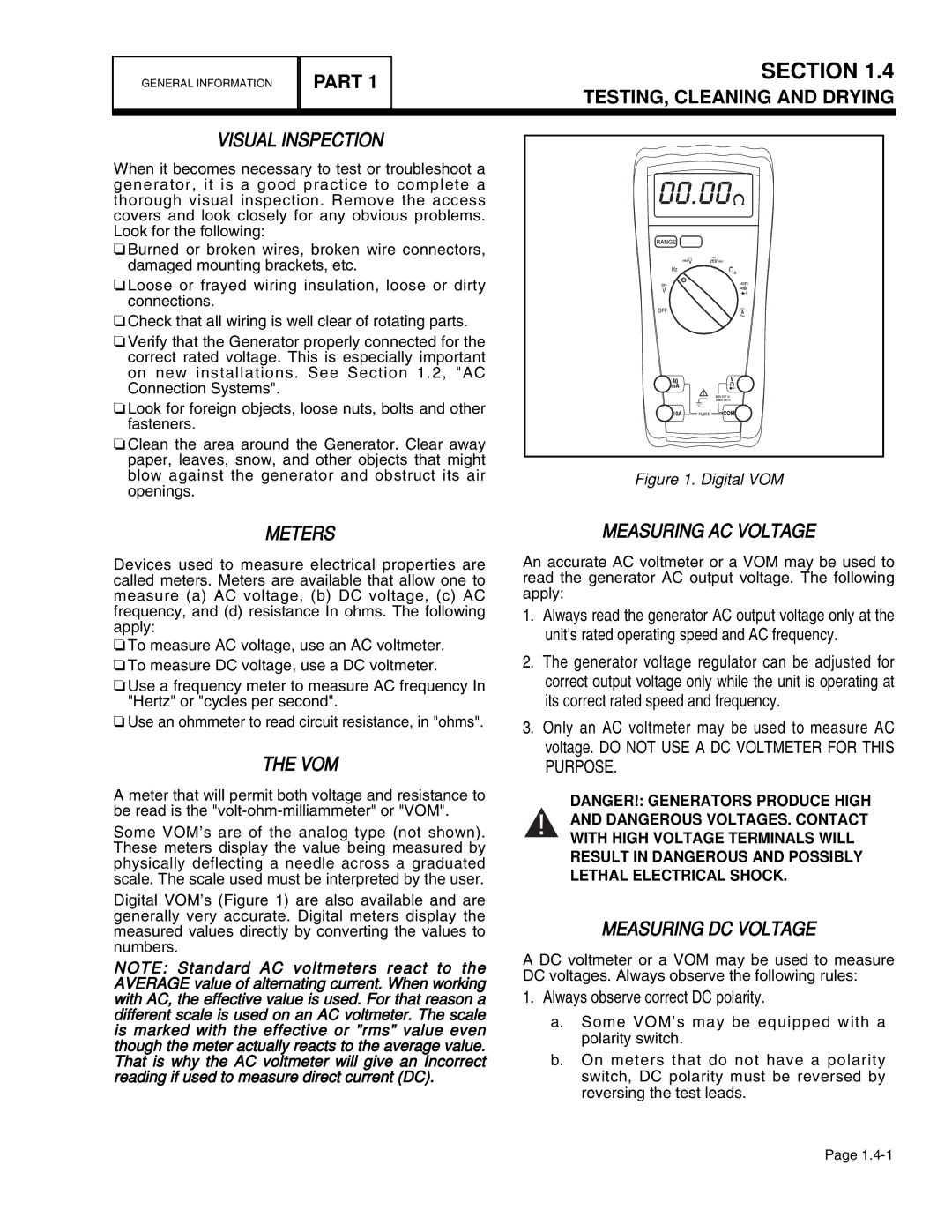
GENERAL INFORMATION
PART 1
SECTION 1.4
TESTING, CLEANING AND DRYING
VISUAL INSPECTION
When it becomes necessary to test or troubleshoot a generator, it is a good practice to complete a thorough visual inspection. Remove the access covers and look closely for any obvious problems. Look for the following:
❏Burned or broken wires, broken wire connectors, damaged mounting brackets, etc.
❏Loose or frayed wiring insulation, loose or dirty connections.
❏Check that all wiring is well clear of rotating parts.
❏Verify that the Generator properly connected for the correct rated voltage. This is especially important on new installations. See Section 1.2, "AC Connection Systems".
❏Look for foreign objects, loose nuts, bolts and other fasteners.
❏Clean the area around the Generator. Clear away paper, leaves, snow, and other objects that might blow against the generator and obstruct its air openings.
METERS
Devices used to measure electrical properties are called meters. Meters are available that allow one to measure (a) AC voltage, (b) DC voltage, (c) AC frequency, and (d) resistance In ohms. The following apply:
❏To measure AC voltage, use an AC voltmeter.
❏To measure DC voltage, use a DC voltmeter.
❏Use a frequency meter to measure AC frequency In "Hertz" or "cycles per second".
❏Use an ohmmeter to read circuit resistance, in "ohms".
THE VOM
A meter that will permit both voltage and resistance to be read is the
Some VOM’s are of the analog type (not shown). These meters display the value being measured by physically deflecting a needle across a graduated scale. The scale used must be interpreted by the user.
Digital VOM’s (Figure 1) are also available and are generally very accurate. Digital meters display the measured values directly by converting the values to numbers.
NOTE: Standard AC voltmeters react to the AVERAGE value of alternating current. When working with AC, the effective value is used. For that reason a different scale is used on an AC voltmeter. The scale is marked with the effective or "rms" value even though the meter actually reacts to the average value. That is why the AC voltmeter will give an Incorrect reading if used to measure direct current (DC).
Figure 1. Digital VOM
MEASURING AC VOLTAGE
An accurate AC voltmeter or a VOM may be used to read the generator AC output voltage. The following apply:
1.Always read the generator AC output voltage only at the unit's rated operating speed and AC frequency.
2.The generator voltage regulator can be adjusted for correct output voltage only while the unit is operating at its correct rated speed and frequency.
3.Only an AC voltmeter may be used to measure AC voltage. DO NOT USE A DC VOLTMETER FOR THIS PURPOSE.
DANGER!: GENERATORS PRODUCE HIGH AND DANGEROUS VOLTAGES. CONTACT WITH HIGH VOLTAGE TERMINALS WILL RESULT IN DANGEROUS AND POSSIBLY LETHAL ELECTRICAL SHOCK.
MEASURING DC VOLTAGE
A DC voltmeter or a VOM may be used to measure DC voltages. Always observe the following rules:
1.Always observe correct DC polarity.
a.Some VOM’s may be equipped with a polarity switch.
b.On meters that do not have a polarity switch, DC polarity must be reversed by reversing the test leads.
Page
